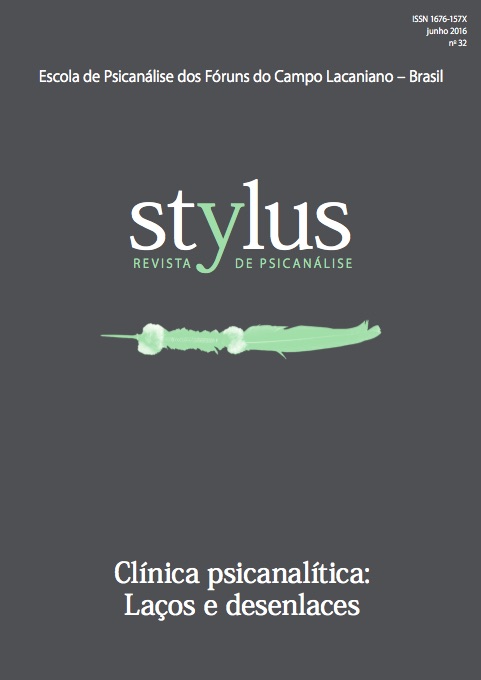Do mel ao fel: Metamorfoses da estratégia de gozo em Roman Polanski¹
DOI:
https://doi.org/10.31683/stylus.vi32.631Keywords:
Neurosis, perversion, clinical structure, jouissance, object a, topology, Seminar 16Abstract
As much as other works in Roman Polanski’s curriculum, “Bitter Moon”, from 1992, exhibited in Brazil as “Lua de Fel”, is a striking movie. At different moments in the footage, the characters Oscar and Mimi trade themselves in the position of torturer and tortured of each other in classical scenes of the recipe BDSM (Bondage/ Discipline, Dominance/Submission, Sadism/Masochism). A desperate search to re-encounter the desire through an erotic sadomasochist woman? Or is it all about something more crucial, of that type of thing that would invite analysts to reflect about the clinical structure of the subjects? This becomes clearer from the part do the movie in which the plot includes the couple Fiona and Nigel. The fact of the author of the romance, Pascal Bruckner, on which the film is based being known for philosophizing and coming up with theories about love, just makes interpretation even more controversial. Although film characters are not to be confused with “clinical cases”, art works have always become a source of potential search for psychoanalysts to go deeper in their stories. The objective of this work is to interrogate the characters from “Bitter moon” and its plot, aiming at a reflection about the distinctive structural aspects between neurosis and perversion. The topological stratified ordering of the Other, perforated by the object a and the functioning of this empty place as a polarizer and core of jouissance attraction – from what Lacan defined the function more-of jouissance – allows them to advance and go deeper into a larger comprehension of the clinical structures of neurosis and perversion.
Downloads
References
of Mental Disorders, Fifth Edition. Arlington: VA, American Psychiatric Association,
2013.
DICTIONNAIRES LE ROBERT. (1988). Micro-Robert Poche. Paris: Robert, 1988.
FREUD, S. (1905). “Três ensaios sobre a teoria da sexualidade”. In: Edição Standard
Brasileira das Obras Psicológicas Completas de Sigmund Freud. Rio de
Janeiro: Imago, 2. ed., 1987, vol. VII.
_________. (1912a). “Sobre a tendência universal à depreciação na esfera do amor”.
In: Edição Standard Brasileira das Obras Psicológicas Completas de Sigmund
Freud. Rio de Janeiro: Imago, 2. ed., 1987, vol. XI. Disponível em: <http://
conexoesclinicas.com.br/wp-content/uploads/2015/01/FREUD-Sigmund.-
-Obras-Completas-Imago-Vol.-11-1910.pdf> [9 fev. 2016].
_________. (1912b). “Sobre la más generalizada degradación de la vida amorosa”.
In: Obras completas de Sigmund Freud. Buenos Aires: Amorrortu, 2. ed., 1986,
vol. XI. Disponível em: <http://www.bibliopsi.org/docs/freud/11%20-%20
Tomo%20XI.pdf> [9 fev. 2016].
_________. (1927). “Fetichismo”. In: Edição Standard Brasileira das Obras Psicológicas
Completas de Sigmund Freud. Rio de Janeiro: Imago, 2. ed., 1987, vol. XXI.
_________. (1950 [1895). “Projeto para uma psicologia científica”. In: Edição Standard
Brasileira das Obras Psicológicas Completas de Sigmund Freud. Rio de
Janeiro: Imago, 2. ed., 1987, vol. I.
GIANESI, A. P. L. (2011). Causalidade e desencadeamento na clínica psicanalítica.
São Paulo: Annablume, 2011.
LACAN, J. (1959-60). O seminário, livro 7: A ética da psicanálise. 2. ed. Rio de
Janeiro: Jorge Zahar Ed., 2008.
_________. (1963). “Kant com Sade”. In: Escritos. Rio de Janeiro, Jorge Zahar Ed.,
1998, pp. 776-803.
_________. (1963). “Subversão do sujeito e dialética do desejo no inconsciente freudiano”.
In: Escritos. Rio de Janeiro: Jorge Zahar Ed., 1998, pp. 807-842.
_________. (1962-63). O seminário, livro 10: A angústia. Rio de Janeiro: Jorge Zahar
Ed., 2005.
_________. (1964). O seminário, livro 11: Os quatro conceitos fundamentais da psicanálise.
Rio de Janeiro: Jorge Zahar Ed., 1988.
_________. (1966). Escritos. Rio de Janeiro: Jorge Zahar Ed., 1998.
_________. (1968-69a). O seminário, livro 16: De um Outro ao outro. Rio de Janeiro:
Jorge Zahar Ed., 2008.
_________. (1968-69b). Le séminaire, livre 16: D’un Autre à l’autre. Disponível em:
<http://staferla.free.fr/S16/S16.htm> [9 fev. 2016].
_________. (1974). “Televisão”. Outros escritos. Rio de Janeiro: Jorge Zahar Ed., 2003.
MARTINHO, M. H. C. (2011). Perversão: um fazer gozar. Tese (Doutorado em
Psicanálise) – Instituto de Psicologia, Universidade do Estado do Rio de Janeiro,
2011.
Downloads
Published
How to Cite
Issue
Section
License
Ao encaminhar os originais, os autores cedem os direitos de publicação para STYLUS.
Os autores assumem toda responsabilidade sobre o conteúdo do trabalho, incluindo as devidas e necessárias autorizações para divulgação de dados coletados e resultados obtidos, isentando a Revista de toda e qualquer responsabilidade neste sentido.



